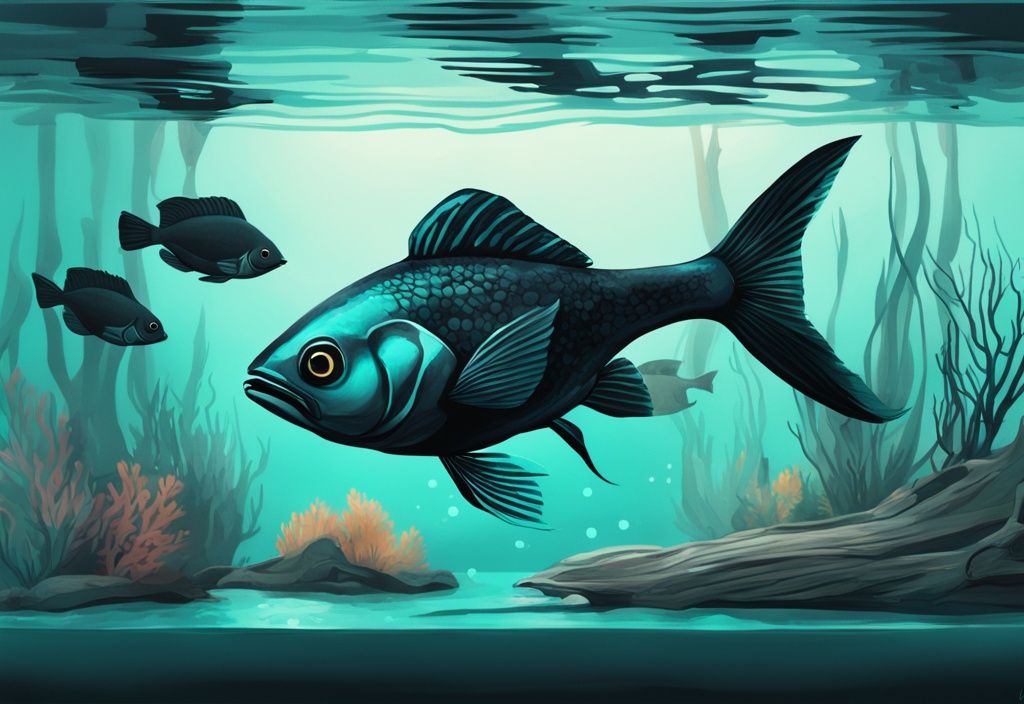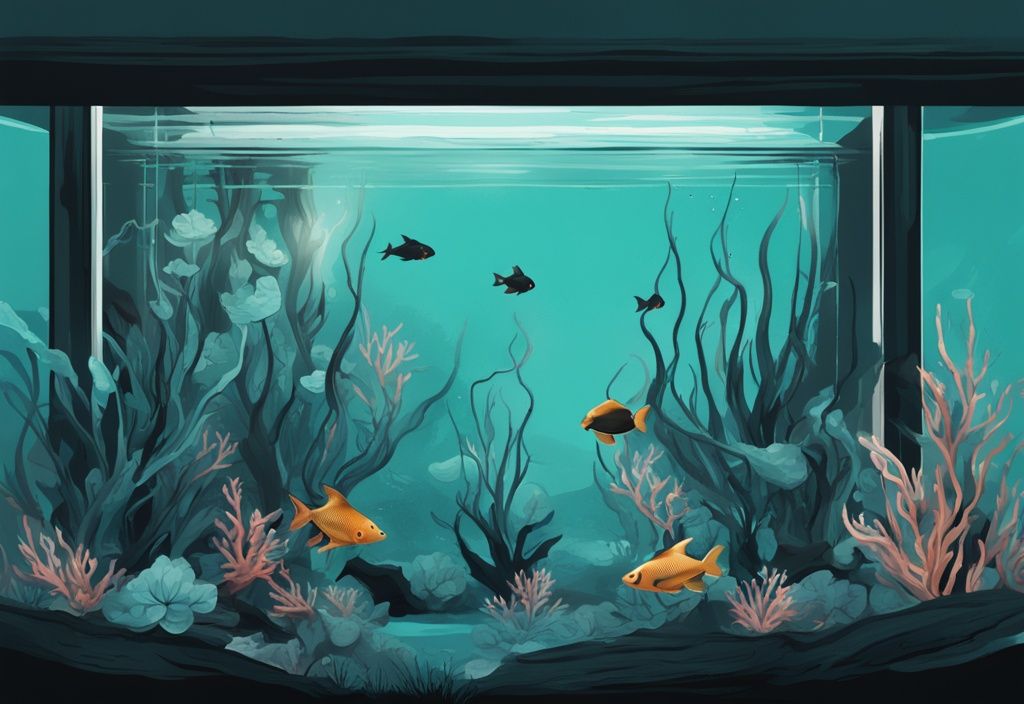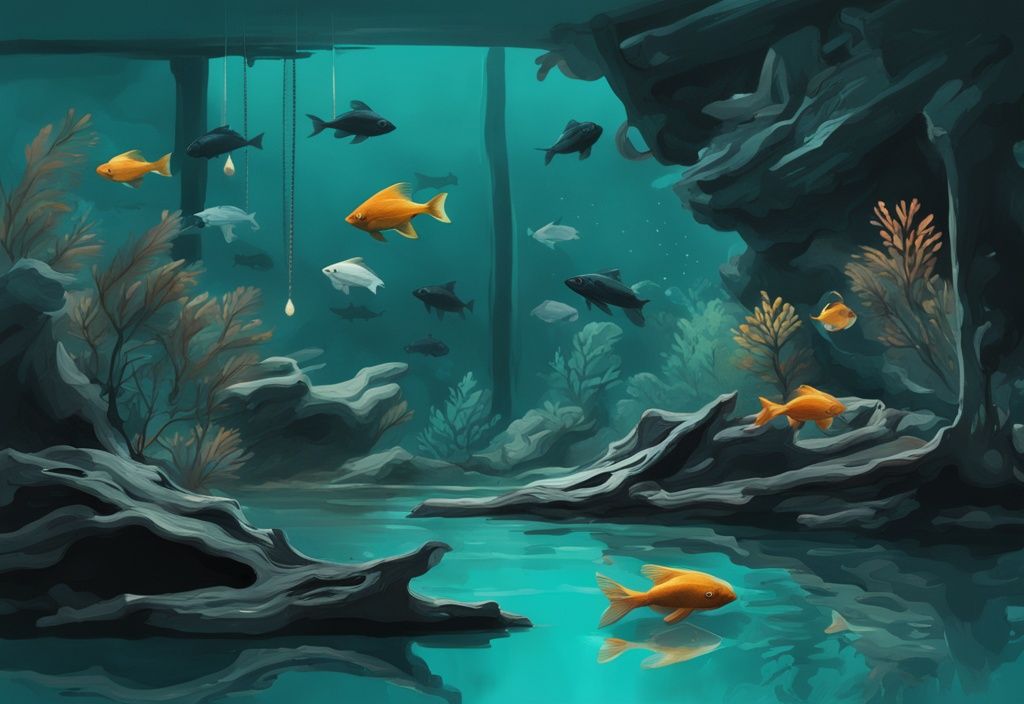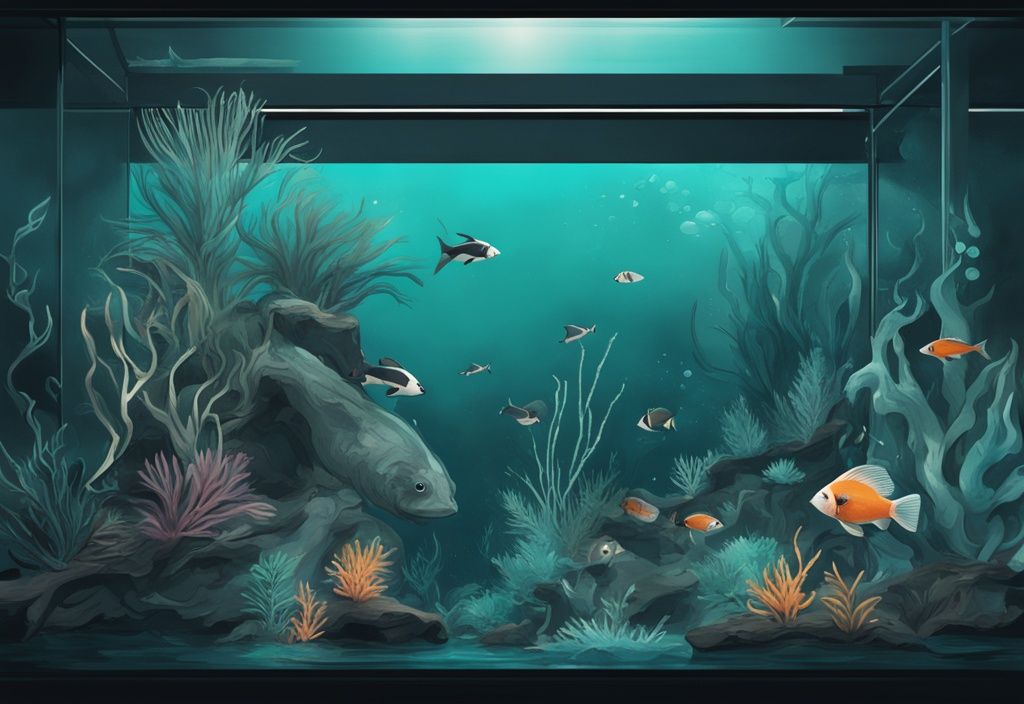Imagine diving into a world beneath the water’s surface, where the ambiance mirrors the mysterious, tea-stained rivers of the Amazon or Southeast Asia. This is the allure of a black water aquarium—a captivating aquatic environment that not only replicates the natural habitats of many fish species but also transforms your living space into a serene, exotic retreat. As a marine biologist, I can assure you that these aquariums are more than just visually stunning; they are a testament to nature’s intricate balance. The tannin-rich waters, akin to a fine cup of tea, create a unique ecosystem that benefits both fish and plants, reducing stress and enhancing vibrant colors. Join me as we explore the essentials of setting up and maintaining your own thriving aquatic paradise.
What is a Black Water Aquarium?
A blackwater aquarium is a remarkable freshwater setup, easily recognized by its dark, tea-colored water. This unique hue is created by introducing natural tannins, which are released from materials like driftwood, peat moss, almond leaves, and other botanicals. The main aim of these aquariums is to mimic the natural habitats of fish species from the Amazon basin and other tropical regions. With their organic and natural look, blackwater aquariums offer a striking visual contrast to traditional setups, creating an immersive and serene environment for both fish and aquarists.
The Science Behind Black Water
The distinctive features of blackwater are defined by its unique chemical makeup, heavily influenced by the geology of the region, especially the drainage from older rocks and soils. Blackwater typically has a low pH range of 4.0 to 6.0 and low levels of dissolved elements like Magnesium, Sodium, Potassium, and Calcium. It also contains high levels of dissolved organic substances. While tannins from leaves and botanical materials contribute to the water’s dark tint, they aren’t the main cause of blackwater’s chemical properties. Instead, the decomposition of these materials releases natural acids and other compounds, resulting in the unique water color and chemistry.
Setting Up Your Black Water Aquarium
Creating a blackwater aquarium involves careful preparation and attention to detail. From selecting the right materials to monitoring water chemistry, each step is crucial in crafting a balanced ecosystem that mirrors the natural beauty of blackwater habitats.
Essential Materials for Black Water Aquariums
To create a blackwater aquarium, start by incorporating materials like driftwood, peat moss, and almond leaves, which release tannins into the water. Common botanicals used include Catappa leaves (Indian almond leaves), oak leaves, banana leaves, and alder cones. It’s crucial to ensure these botanicals are safe by boiling or soaking them in hot water to remove any pests and toxins before adding them to the tank. Additionally, blackwater aquarium additives can be used to achieve the desired water color and pH level, helping maintain the chemical balance and aesthetic appeal of the aquarium.
Step-by-Step Guide to Setting Up
Begin by preparing the tank with materials like driftwood and botanicals. Fill the tank with water and allow the tannins to release over several days. Adjust the filter outlet to create a slow water flow, mimicking natural conditions. Introduce tannins gradually to avoid shocking the fish with sudden changes in water chemistry. It’s important to monitor the water color and pH levels to ensure they remain within the desired range, providing a stable and healthy environment for the aquarium’s inhabitants.
What is a Black Water Aquarium?
A blackwater aquarium is a captivating type of freshwater setup, distinguished by its dark, tea-colored water. This unique hue is crafted through the release of natural tannins from materials like driftwood, peat moss, almond leaves, and various botanicals. These elements not only enhance the aesthetic appeal but also play a crucial role in recreating the natural habitats of fish species native to the Amazon basin and other tropical regions.
The primary aim of a blackwater aquarium is to mimic the tranquil and organic environment found in these natural habitats. This involves establishing an ecosystem that closely mirrors the conditions these fish are accustomed to in the wild. The tannin-rich water, slightly acidic in nature, creates an ideal setting for species that flourish in such conditions, promoting their health and natural behaviors.
Visually, blackwater aquariums provide a striking contrast to traditional setups. The dark water serves as a dramatic backdrop, highlighting the vibrant colors of the fish and plants within. This natural and organic look not only enhances visual appeal but also offers a more authentic and calming environment for both the aquarist and the aquatic life. By embracing the beauty of nature, blackwater aquariums offer a unique and enriching experience for enthusiasts seeking to create a more naturalistic aquatic display.
The Science Behind Black Water
Blackwater aquariums are captivating ecosystems, defined by their unique chemical makeup, which is deeply influenced by geological factors. Imagine the water in these aquariums as a product of ancient landscapes, where old rocks and soils contribute to the drainage, creating a distinct chemical profile. This environment is characterized by a low pH range, usually between 4.0 and 6.0, along with low concentrations of dissolved minerals like Magnesium, Sodium, Potassium, and Calcium. These conditions foster a soft water environment, rich in dissolved organic substances.
The dark, tea-colored hue of blackwater is primarily due to tannins, released from natural materials like leaves and botanicals. However, tannins are not the main players in the water’s chemical properties. Instead, it’s the decomposition of organic materials that plays a crucial role in shaping the water chemistry. As leaves and botanicals break down, they release natural acids and other compounds into the water. This process not only enhances the water’s color but also contributes to the unique chemical environment that defines blackwater aquariums.
Understanding the science behind blackwater is essential for aquarists aiming to replicate these conditions in their tanks. By carefully managing the introduction of tannins and monitoring the water’s pH and mineral content, enthusiasts can create a thriving habitat that mirrors the natural ecosystems found in regions like the Amazon basin. It’s a bit like recreating a piece of the rainforest in your living room, where each element plays a part in the delicate balance of life.
Setting Up Your Black Water Aquarium
Creating a black water aquarium is a rewarding endeavor that involves careful selection of materials and attention to detail. In the following sections, you’ll find a detailed guide on the essential materials needed and a step-by-step process to set up your own black water haven.
Essential Materials for Black Water Aquariums
To craft the perfect black water aquarium, you’ll need a selection of natural materials. The backbone of this setup includes driftwood, peat moss, and almond leaves. These elements are essential as they release tannins, giving the water its signature tea-colored hue. Think of it as brewing a cup of tea, but for your fish!

Among the botanicals, Catappa leaves, oak leaves, banana leaves, and alder cones are popular choices. These botanicals not only enhance the aesthetic but also help maintain the water’s chemical balance. Before adding them to your aquarium, ensure they are free from pests and toxins. A good soak or boil in hot water is a simple way to make them safe for your underwater world.
In addition to these natural materials, consider using blackwater aquarium additives. These can help fine-tune the water’s color and pH levels, supporting a balanced ecosystem and adding to the visual appeal of your aquarium.
Step-by-Step Guide to Setting Up
Setting up a black water aquarium is a journey that requires patience and precision. Start by preparing your tank with the chosen materials, such as driftwood and botanicals. Once in place, fill the tank with water and let the tannins gradually infuse over several days. This slow release is key to achieving the desired water color and chemistry.
Next, adjust the filter outlet to create a gentle water flow. This mimics the natural conditions of blackwater habitats and is crucial for maintaining a stable environment for your fish and plants.
When introducing tannins, do so gradually. Sudden changes in water chemistry can stress your fish. Regularly monitor the water color and pH levels to ensure conditions remain optimal. This careful observation promotes a healthy and vibrant aquarium ecosystem.
Maintaining Your Black Water Aquarium
Creating a thriving black water aquarium is like orchestrating a delicate symphony. Each component plays a crucial role in maintaining harmony within this unique aquatic environment. From regular water changes to vigilant monitoring of water parameters, every action contributes to the well-being of your aquatic life.
Importance of Regular Water Changes
Imagine your black water aquarium as a finely tuned instrument. Regular water changes are akin to the gentle adjustments needed to keep it in perfect pitch. While tannins are beneficial, they can gradually lower the pH and soften the water. To prevent these fluctuations from becoming a cacophony, it’s essential to perform water changes with care and consistency.
This process helps stabilize the pH and kH levels, creating a harmonious environment for your aquatic life. Think of pre-treating the new water with botanicals as setting the stage for a seamless transition. It helps match the existing conditions, minimizing stress on the fish and plants, much like a conductor ensuring each musician is in sync.
Monitoring Water Parameters
Keeping a close eye on water parameters is like reading the sheet music of your aquarium. Regular testing allows you to monitor the pH, kH, and tannin levels, ensuring they remain within the optimal range for your fish and plants. This vigilance helps maintain a stable and healthy environment, preventing potential issues before they arise.
Periodically, you may need to add additional tannins or blackwater additives to sustain the desired water color and chemistry. By actively managing these parameters, you can create a thriving ecosystem that mimics the natural habitats of your aquatic inhabitants. It’s like conducting a symphony where every note is perfectly in tune, resulting in a mesmerizing performance.
Choosing the Right Fish and Plants for Black Water Aquariums
Creating a thriving black water aquarium requires careful selection of fish and plants that naturally flourish in these unique environments. From vibrant fish species to lush plant life, each choice contributes to a balanced ecosystem that mimics the serene beauty of nature.

Fish Species That Thrive in Black Water
Imagine the soft, mysterious waters of the Amazon basin, where Angelfish, tetras, corydoras, and certain cichlids dance gracefully among the submerged roots. These South American fish are accustomed to the soft, acidic waters, making them perfect candidates for your black water aquarium. Their vibrant colors pop against the dark backdrop, creating a mesmerizing display that captures the essence of their natural habitat.
But let’s not forget our Asian friends! Gouramis, bettas, and barbs are equally at home in tannin-rich waters. Picture them gliding through the slow-moving streams and ponds of Asia, where the water mirrors the conditions of a black water setup. By choosing these naturally adapted species, you ensure a healthy, harmonious environment where your fish can thrive.
Plant Species That Flourish in Black Water
Now, let’s talk greenery. In the dim, enchanting world of a black water aquarium, low-light plants are the stars. Consider Java fern, anubias, and bucephalandra. These hardy epiphytes thrive when attached to rocks or driftwood, adding a touch of lush elegance without demanding intense lighting.
Floating plants like salvinias and red root floaters bring more than just beauty. They provide shade, creating a natural canopy that mimics the dappled sunlight of a forest. This not only enhances the aesthetic appeal but also offers shelter for your fish. Plus, these plants play a crucial role in maintaining water quality by absorbing excess nutrients. By incorporating these plant species, you create a balanced and visually stunning black water aquarium that echoes the tranquility of nature.
Benefits of Black Water Aquariums
Black water aquariums offer a unique and beneficial environment for both fish and aquarists. These aquariums replicate the natural habitats of many tropical fish species, providing a range of advantages that enhance the well-being and beauty of aquatic life.
How Black Water Reduces Stress for Fish
Imagine your fish swimming in a serene, tea-colored haven, reminiscent of their native rivers and streams. Black water aquariums create such an environment, rich in tannins, which are natural compounds that help reduce stress. This comforting setting makes fish feel more secure, reducing their susceptibility to stress-related illnesses. The gentle, subdued lighting mimics their natural habitat, encouraging fish to display a full spectrum of behaviors. You’ll notice them exploring and interacting more, showcasing a vibrant and lively aquarium scene.
Enhancing Fish Colors with Black Water
The magic of black water aquariums lies in their ability to bring out the best in your fish’s colors. Tannins and organic compounds in the water enhance the natural hues of fish, making them appear more vivid. This effect is especially striking in species native to black water environments, where the darker backdrop highlights their vibrant colors. Moreover, the slightly acidic conditions fostered by tannins contribute to healthy skin and scales, adding to the fish’s overall brilliance. This combination of factors doesn’t just create a stunning visual display; it also supports the health and vitality of your aquatic friends.
Debunking Common Misconceptions About Black Water Aquariums
Black water aquariums often spark curiosity and sometimes confusion. Let’s dive into some common myths and truths about these unique aquatic environments.
Dark Water Myths
Many assume that the dark water in black water aquariums signals poor water quality or an unhealthy habitat for fish. However, this couldn’t be further from the truth. The rich, dark hue comes from natural tannins released by driftwood and botanicals. These elements are deliberately added to craft a specific ecological setting. Tannins are not just for show; they offer antibacterial and antifungal benefits, enhancing the well-being of the aquarium’s residents.
Regular maintenance, such as water changes and monitoring parameters, ensures that a black water aquarium is as vibrant and healthy as any other type. The secret lies in recognizing that the darker appearance is a purposeful choice, not a sign of neglect. Certain fish species thrive in these conditions, making it a beneficial environment.
Understanding True Blackwater
Creating a true blackwater environment is more than just achieving a dark water color. It involves replicating specific conditions found in natural blackwater habitats. These include a low pH, low mineral content, and high levels of dissolved organic substances. Many hobbyists opt for “botanical-style” aquariums, which incorporate elements of blackwater environments, such as adding botanicals to tint the water. However, these setups may not fully replicate the chemical properties of true blackwater.
Understanding this distinction is crucial for aquarists who aim to provide an authentic habitat for species that flourish in these conditions. While crafting a true blackwater environment can be complex, even a botanical-style aquarium offers many benefits associated with blackwater, such as reduced stress and enhanced coloration in fish.

Success Tips for Black Water Aquariums
Creating a thriving black water aquarium involves understanding the unique needs of this captivating aquatic environment. From choosing the right setup to selecting compatible species, each step plays a crucial role in crafting a balanced ecosystem that mirrors the enchanting beauty of natural black water habitats.
Starting with a Small Setup
Embarking on your black water aquarium journey with a smaller setup can be a wise choice. Think of it as dipping your toes into a serene pond before diving into a lake. A compact tank is easier to manage and allows for precise monitoring of water conditions, which is vital for maintaining the delicate balance required in a black water environment.
As the water darkens over time due to the release of tannins, patience becomes your best friend. This gradual transformation not only enhances the tank’s aesthetic appeal but also ensures a stable and healthy habitat for your aquatic life. By starting small, you can fine-tune your skills in managing water chemistry and make necessary adjustments without feeling overwhelmed.
Choosing the Right Species
Selecting the appropriate fish species is akin to choosing the perfect cast for a play. Each fish brings its own character and flair, and those naturally thriving in black water conditions are the stars of this show. South American and Asian species, for instance, are well-adapted to the unique water chemistry and darker conditions.
Thorough research into the specific needs and preferences of potential inhabitants is essential. By choosing species well-suited to the black water habitat, you create a harmonious ecosystem where fish exhibit natural behaviors and vibrant colors. This not only enhances the overall beauty of your aquarium but also ensures the health and well-being of its inhabitants.
FAQ
What makes a black water aquarium different from a regular aquarium?
Imagine stepping into a serene forest stream, where the water is tinged with a rich, tea-like hue. That’s the essence of a blackwater aquarium. These aquariums mimic the natural habitats of certain South American and Asian fish species, thanks to tannins that give the water its distinctive color. This creates not just a unique aesthetic but also a specific water chemistry that some fish absolutely adore.
How do I maintain the water color in a black water aquarium?
Keeping that enchanting water color is like brewing the perfect cup of tea. Regularly add botanicals or blackwater additives to maintain the hue. It’s a bit of a balancing act—monitor tannin levels closely and adjust as needed to keep water chemistry stable and the color just right.
Are black water aquariums suitable for all fish species?
Not every fish is ready to don a snorkel and dive into blackwater conditions. It’s essential to choose species that naturally thrive or adapt well to these environments. This ensures your finned friends are not just surviving, but thriving, in their tea-colored paradise.
What are the benefits of tannins in a black water aquarium?
Tannins are like the unsung heroes of the aquarium world. They offer antibacterial and antifungal properties, lower pH, and create slightly acidic water. This environment can enhance fish health and even promote successful breeding conditions. It’s like setting up a cozy home for your fish.
How often should I change the water in a black water aquarium?
Water changes are crucial, but think of it as a gentle spring cleaning. You want to avoid any drastic changes in water parameters. Regular, careful water changes ensure a stable and healthy environment, keeping your aquatic ecosystem balanced and thriving.
Conclusion
Blackwater aquariums are a remarkable choice for aquarists who wish to capture the tranquil allure of tropical waters. Picture this: a tank with a tea-colored hue that not only adds a unique aesthetic to your home but also nurtures both fish and plants. The rich tannins and specific water chemistry create a habitat that mirrors the natural ecosystems of certain fish species, promoting their health and vitality. It’s like bringing a slice of the Amazon into your living room.
Understanding the specific needs of a blackwater aquarium is crucial for its success. Think of it as a delicate dance—maintaining the right water chemistry involves careful monitoring of pH levels and the gradual introduction of tannins. This prevents shocking your aquatic inhabitants. Regular water changes, while keeping conditions stable, are essential to ensure the longevity and well-being of the ecosystem.
Patience and meticulous care are key when setting up a blackwater aquarium. Over time, as the water darkens and the environment stabilizes, you’ll witness a thriving, vibrant ecosystem. With dedication and proper management, blackwater aquariums can transform any space into a tranquil and captivating aquatic haven. They offer endless enjoyment and a deeper connection to nature.
